Name
Riga. The long stroke (=macron) above the "i" means that it's a long vowel (hence pronounced "Reeguh"). This has always been the name of the city and that's also the way it's pronounced in almost every language. In Russian for example it's also Рига (Riga). The present-day old town was once occupied by Lake Riga, which again was located in the estuary of the river Rīdziņa into the river Daugava. The town name might origin in the old name of the river.
Location

| ||
| Riga |
The main part of Riga occupies the right (eastern) bank of the 1,025 km long river Daugava (aka Düna), but some newer districts of Riga nowadays stretch along the left bank. The Daugava originates in Russia near the spring of the mighty river Volga, crosses the entire →Belarus before it enters Latvia and finally empties into the Rīgas Jūras līcis (Bay of Riga) or the Baltic Sea respectively, which is only 15 km away from Riga to the north. There are several long islands in the Daugava, some of them being used as a part of urban development. The river itself is between 500 m and 1 km wide near Riga. The area around the capital is rather flat with very few hills nearby.
Population
Riga has slightly less then 750,000 inhabitants, which not only makes it the biggest town in Latvia but also the largest city of the three Baltic states. However, the population is steadily decreasing. Some 43.5% are Russians, outnumbering Latvians (41.5%) and some minorities such as Belarusians, Ukrainians, Poles etc (as of 2002).
Orientation

| ||
| Panorama of Riga and the river Daugava |
Riga is clearly divided into the old town and the new town. The Vecrīga (Old town / lit. Old Riga) is a clearly separated area stretching along the east bank of the Daugava river. The old town is some 1.5 km long and only 500 m wide. The entire area is separated from the rest by a small channel and spacious parks. South of the old town lies the main transport hub - the Autoosta (bus terminal) and close to it the Centrālā Stacija (Central Station). Once there, one can't miss the large Centrāltirgus (central market) with its large halls and the hypermodern shopping mall including some cinemas between the bus terminal and the train station.
Northeast of the old town starts Jaunā Rīga (New Riga), with numerous apartment buildings from the time after 1900, with some modern hotels and much more. Riga also stretches a few kilometers inland along the river Daugava. There are vast residential and industrial areas in the south and the east. Three large bridges connect the eastern part with the western part in the centre of town. Opposite the old town lies the large island of Ķipsala, which is mostly used as an industrial area.
History
The first real settlement in present-day Riga was probably founded in the 11th or 12th century. The settlement first appeared in chronicles with its present name in the year 1198. After that, Riga developed quickly. In 1201, Riga was granted the status of a town by the Bremen bishop Albert. Soon after that, Riga became the capital of Livonia (Livland). It developed into an imortant trade centre and since 1255 the seat of the archbishop. Already in 1282 Riga joined the Hanseatic League. As in many cities of the Baltic area, the town was mostly dominated by German knights and merchants.
Riga gradually grew bigger and bigger. From 1561 to 1581, the town was even officially granted the status of a free city, but this was to be followed by a turbulent period. First, Riga was occupied and ruled by Poland - Lithuania, and in 1621 it fell to Sweden. The next big change happened during the Great Northern War , as a result of which Riga was largely destroyed and occupied by Russia. The tsar made Riga the capital of the Baltic Sea dependancy, which helped the town again to develo quickly. It's still surprising that even than German remained the official language until the late 19th century. At that time, more than half of Riga's inhabitants at that time were Baltic Germans.
During World War I, the front line remained close to Riga for a while, causing a lot of damage in the city. But Riga recovered soon after the end of the war, and naturally became the capital of now - for the first time in history - independent Latvia. However, the peaceful period didn't last long. Same as the rest of the country, Riga fell victim to the great game played by Nazi Germany and Stalin's Soviet Union. In 1940, the Red Army annexed the town. In 1941, the German Wehrmacht drove the Russians out of the city. In 1944, the Red Army was back, but only after heavy fightings. Large parts of the old town were in ruins then.
There was a clear tendency to push the Latvian language out of the public space - the town was about to be russified. In 1990, Latvia could declare its independence for the second time, and of course Riga became capital again. Since then, much has changed. The economic boom after 1990 is evident throughout the town, and much was done to bring the old town back to its past glory. This was eventually honoured by the UNESCO when it declared the entire old town world cultural heritage.
Getting there / transportation
See the chapter →Latvia: Getting there for extensive information on how to get to Riga.
Inside the city, it's best to get around on busses, trams and trolley busses. The public transportation network is quite dense but mostly spares the old town for obvious reasons. One of the main hubs is the area between the train station and the main bus terminal. A ride on a bus or tram costs 0.20 Lats but I'm sure it will be more in the near future. Tickets are to be bought on board.
Most visitors will be very surprised when approaching Riga from the other side of the Daugava - the skyline of the old town is a stunning sight. Many visitors will also be surprised when noticing how vibrant the town is. Riga - in my opinion - is the most actice and modern capital in the three Baltic States. And yet it has a widely homogeneous and beautiful old centre of town. Right in the centre of town there's the Akmens Tilts (Stone Bridge) - one of three bridges in the centre of Riga crossing the wide river Daugava. There's heavy traffic on and around the bridge, but only a few hundred meters away from the bridge it's nice and quiet in Riga's small alleys.
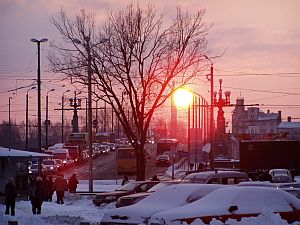
| ||
| A view across the Daugava at Akmens-bridge towards Ķipsala |
Almost every visitor arrives either at the Autoosta (bus terminal) or the Centrālā Stacija (main train station), located at the southern fringe of the old town. Riga's characteristic market halls line up opposite the bus terminal along a small channel. Those market halls probably haven't changed much since the end of the Soviet Union - inside the vibrant market, meat, fruits and vegetables are being sold. Right next to the train station on the other side of a wide road stands the large, hypermodern shopping mall called Stockmann, a Swedish supermarket chain, with the Forum Cinemas inside. This modern building offers a sharp contrast to the market halls and the old town. The complex is also home to a handful of restaurants. South of the shopping centre and the bus and train stations starts the modern Riga, mainly dominated by the stalinist wedding-cake style skyscraper (well, at least in this area it is one) of the Zinātņu Akadēmija (Academy of Science) - similar buildings can be found in Moscow and →Warsaw just to name but a few.
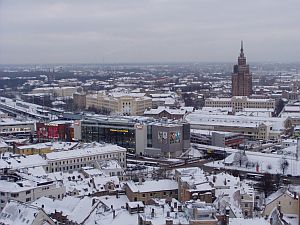
| ||
| The modern shopping centre and the southern part of Riga |
From the above-mentioned bridge it's only a few metres to the Rātslaukums (City Hall Square), which is characterized by a red structure called the Melngalvju Nams (Guild House of Blackheads). No building can be more typical for the Hanseatic League then this one. It was first built around 1334, shortly after Riga was founded. Besides its numerous ornaments, it is famous for its large astronomic clock. Below the clock there are four beautiful crests depicting the four most important Hanseatic cities - namely Hamburg, Lübeck, Bremen and - Riga. The crests are emphasized by some ancient Greek figures. As the name is already showing, this guild house once belonged to the powerful Blackheads Guild, whose members were mainly German merchants. Unfortunately, the guild house was almost entirely destroyed during German air raids in 1941 and not rebuilt before 1999. It's not only the facade that was rebuilt but also the entire interior. Among other institutions, the guild house now houses the tourist information.
Next to the guild house stands a large and somehow disturbing black block. This modern structure is home to the Latvijas Okupācijas Muzejs - Latvian Occupation Museum. The well-arranged exhibition inside shows life in Latvia during the Soviet and the German occupation and is well worth a visit. Entrance fee is 0.50 Lats.
The square in front of the guild house is guarded by the Roland - a statue with a large sword which was typical for Hanseatic (and other towns) during medieval times - symbolizing that this place had its own jurisdiction. Needless to say that the City Hall Square also features a Rātsnams (City Hall), which was also destroyed during air raids and rebuilt much later. However, today it isn't used as a city hall any longer.
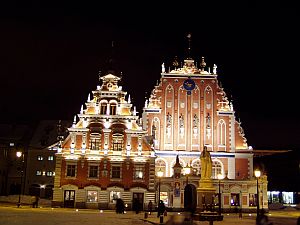
| ||
| The beautiful Guild House of Blackheads |
Only a few dozen metres away from the guild house, the large Sv. Pātera Baznīca (St. Peter's Church) towers over the old town of Riga. Once a twin towered structure, this church is partially evangelic and partially catholic - the latter is also referred to as St Jacob's church. The church was built shortly after the foundation of Riga at the beginning of the 13th century, making it one of the oldest churches in town. The tower was destoryed not just once, and so the church changed its appearance many times. The present form dates back to the 18th century. There's an interesting legend connected to the church: After remodeling the church, the master builder emptied a glass of wine and threw the glass on the street from the top of the church. The glass hit a cart carrying bales of straw passing the church - and therefore didn't break apart. However, the number of glass splinters was supposed to tell the number of years the church in its present form will last. Naturally the result was taken as a portent, but after all the church lasted some 200 years - until it was heavily damaged during World War II and rebuilt during Soviet Union times.
The church tower is 123 m high and dominates the skyline of Riga. A lift (!) takes visitors to an altitute of 72 m, where visitors can enjoy the marvellous panorama of the old town of Riga from an observation platform (see panorama at the top). On clear days it's even possible to see the Baltic Sea. The lift is operated by a very charming old man - hope he'll be in charge for many more years! Entrance fee is 2 Ls, students pay half the price.
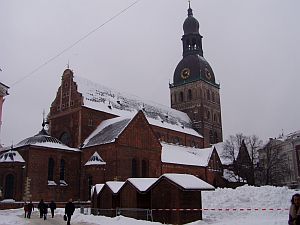
| ||
| The impressive Doma Cathedral of Riga |
Of course there are many more churches in Riga, of which especially the Rīgas Doms is worth mentioning. This huge church is only 300 m away from the Guild house to the north at the Doma Laukums (Cathedral Square). The construction of the cathedral startet in 1211 in the romanesque style, but later on it was reconstructed several times. The present-day appearance dates back to the late 18th century and includes some baroque elements. The 90 m high tower is substantially smaller then the one of the above mentioned St. Peter's Church. The cathedral once was the centre of the Livonian Diocese which was stretching well into present-day →Estonia. It's not only impressive from outside but also from inside with beautiful glas paintings and an organ with some 7,000 pipes. Apart from St. Peter's Church and the dome, St. John church and St. Jacob cathedral are worth visiting as well.
When walking from Cathedral Square along the narrow lane Pils iela (Castle rd.) to the northwest, it takes a few minutes only to get straight to the large Rīgas Pils (Riga castle). The massive construction was erected around the year 1300 and was mainly used by the German knights as their residence. Therefore the castle was heavily fortified and served as a part of the defense system of Riga. The front part is now being used as museum - namely the Latvian History Museum and an exhibition of foreign art. The back part is now the President's Residence. The castle marks the northern edge of the old town of Riga.
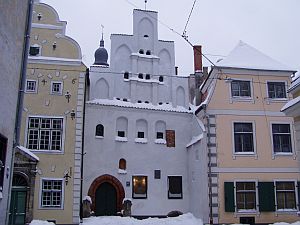
| ||
| Riga: One of the three brethren |
Highly interesting are Riga's numerous historical lanes criss-crossing the old town. Right in front of the caste lies a square called Alus Arsenāls (Beer Arsenal!?). From there, a very narrow lane called Mazā Pils iela (Small castle lane) runs southeastwards. Halfway, three narrow houses leaning against each other catch the eye of the visitor. This ensemble is known as the Trī Brāļi (Three Brethren). The three buildings were built in different times and therefore do not have much in common. House No 17 (see picture) is somehow crooked and twisted - this is due to the fact, that because of the relocation of rivers and channels parts of the old town started to sink.
When turning left before the Three Brethren, it's only a few dozen metres to the St. Jacobs Cathedral dating back to the 13th century. Right behind the cathedral stands the Latvian Saeima (Parliament) (note the Latvian word for parliament: Saeima strongly resembles the Polish word for "parliament" - namely 'Sejm'). The exhibition halls known as Arsenāls behind the parliament mark the limits of Riga old town - to the east, this old town border is characterized by large wall. There are many more interesting lanes around. One of them is the Smilšu iela (Sand lane) starting at Cathedral Square and leading eastwards - here, many beautiful Art Noveau buildings can be found.
The last part of that lane is characterized by the round Pulvertornis (Powder Tower) dating back to the 14th century. Attached to the tower (or vice versa) is the large and dark building sheltering the Latvijas Kara Muzejs (Latvian War Museum), dealing with all past conflicts in the wider area so far and everything you ever wanted to know about the Latvian Armee. For just 0.50 Lats this is all yours - this is something for long, cold and dread winter days.

| ||
| Troksnu lane - one of the beautiful lanes |
Another lane worth visiting is the Trokšņu iela (Noisy Lane). This one starts at the Parliament and is very narrow and peaceful today, but centuries ago it was used as a market place. Along the lane it's possible to get a glimpse of parts of the old town wall. Yet another beautiful lane is the scenic Meistaru iela (Meister Lane?) starting at the Powder Tower and leading all the way to the central, park-like Līvu Laukums (Livonian Square). The northern corner of the latter is characterized by the Kaķu Māja (Cat House) which can't be missed. A small tower on the top of the corner of this beautiful building is charcterised by a crooked cat, which, according to an old tale, shows its backside towards the Guild House. It was said that this was some sort of revenge by the Latvian landlord who was denied membership in the Guild because he was Latvian.
South of the Livonian Square starts the R. Vāgnera iela (Wagner Street). This nice street is one of Riga's shopping streets with numerous shops and boutiques. The street leads straight to Centrs Universālveikals - a large shopping centre. All the other small lanes in the southern part of the old town are worth exploring as well - at day as well as at night.
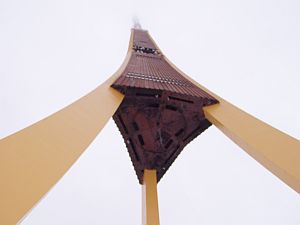
| ||
| The fancy TV tower of Riga |
There's also plenty to see outside the old town. A short walk to Hotel Latvija is highly recommended. This large hotel east of the old town amidst the new town can't be missed. To get there, one has to cross a long park straddling along the tiny Pilsētas Kanāls (Castle Channel). The park as well as the channel enclose the old town almost completely. In the middle of the park stands the National Opera building and the Monument of Freedom. From there it's less then 10 minutes on foot to the 27-storey Hotel Latvija. This modern hotel has a lovely Skyline Bar on the 26. floor - a glass elevator runs straight to the bar. The bar itself is quite chichi and looks very expensive, but a cup of coffee is 1.20 Lats (Beer 1.50 Lats) only. Needless to say that the view from the skyline bar is breathtaking - large parts of the old town can be seen from there.
Talking about a great view - once in Riga, one might as well go all the way to the Rīgas radio un televīzijas tornis (TV tower). The tower sits atop the southern tip of the long but narrow Zaķusala Island in the river Daugava and is a few kilometres away from the centre. The 368.5 m high tower is third largest building in Europe and of course the largest in Latvia. The architecture is quite interesting - the tower is built on three, almost 90 m high bevelled pillars - which contain elevators. This means that these elevators do not just simply move vertically. The elevator whisks visitors up to the 97 m high observation platform. From there, it's a great view not just over Riga but also over the closer surrounding. It took some 10 years to finish the construction in 1989. A trolleybus runs from the central bus station to the island, but it takes a while to walk from there to the tower. Entrance fee is 1.20 Lats.
From Riga it's about 15 km to the northwest to the town of Jūrmala, which can be simply translated as "beach". As a matter of fact, this is not a town but a long string of baths stretching along the coast of the Bay of Riga - the perfect place for a short trip inn summer so to say. The area is easily accessible by local trains as well as by boat.
Riga offers plenty of accommodation - from dirt cheap to really posh and expensive. We were looking for the Old Town Hostel in Kaleju street near the central bus terminal but already in the old town. However, afterwards we found out that we probably ended in the wrong place with a pretty similar name (something with old town and hostel too) but located two blocks away in Vaļņu street.
That place was brand new, parts of it were still under construction, but it was a good place to stay with four dormitories located on four floors. A bed in a dorm cost 5 Lats (€ 7.50). Coffee and tea were available for free in the shared kitchen in the basement. We were rather looking for a double room, but they offered us to stay in a 6 bed dorm with only the two of us (my wife and me so to say) for 7 Lats per person. Each dorm has its own toilet and shower. The location can't be much better - it's three minutes on foot to the bus terminal and 5 minutes to Livonian square. Also, there are numerous bars and restaurants as well as a supermarket and an internet café nearby. Unfortunately I don't have the exact address, but it's impossible to miss. Just walk from the bus station direction old town, pass the tunnel and go straight ahead - this is where Vaļņu street starts. The hostel is on the left side and marked by the international youth hostel symbol.
Addition: There were indeed two Old town hostels. One has been renamed by now. The one mentioned above is this one: 43 Valnu Str., Riga, LV-1050, Tel: + 371 7223406, info@rigaoldtownhostel.lv. The other one (not sure if it's good as well but I guess so) is now called Argonaut Hostel, Kaleju Str. 50 (very close), Tel: +371 6147214, online reservation possible, see http://www.argonauthostel.com.
There are some more hostels and countless hotels - almost all of them close to the centre and, at least the hostels, more then affordable.
- www.riga.lv: Official website of the city of Riga. Comes in English, Russian and Latvian.
- www.rigatourism.com: As the name already says - this is the official website of the tourist office of Riga. Useful and in English, Russian and Latvian.
- www.inyourpocket.com/latvia/riga: Always helpful and a good reference: The In Your Pocket Guide, in English.
Do you have or do you know a good website about Riga? Don't hesitate, let me know! After checking it, I would love to add it to the link list. You can submit a link by using the →contact form. Note that commercial websites will be treated differently.
©2024 Europe-East.com

 Albania
Albania Latvia
Latvia